High-Level Spinal Cord Injuries and Their Causes
Among all levels of paralysis, high-level spinal cord injuries are considered the most serious. This is because injuries to this area of the spinal cord affect all four limbs and in many cases the diaphragm, leaving the person in need of a ventilator. All breathing function is controlled via the diaphragm, and since nerve control of the diaphragm is controlled with the nerves found under the C1 vertebrae in the neck, any injury in the C1-C3 area can affect a person's ability to breathe.
Since this level of quadriplegia can be such a severe injury, special care is needed to ensure people with this level remain healthy and have average lifespans. Only in the last 40 or so years has it become commonplace for people who use ventilators full-time to be able to live at home. This is because of an increase in technology and medicine to control respiratory conditions that result from using a ventilator.
Read on to discover more about high cervical spinal cord injuries, including the most common causes and how they affect a person’s day-to-day life.
Common Causes of High Cervical Injuries

High cervical injuries are quite uncommon. There are only around 140,000 quadriplegics living in the United States. In total, there are 291,000 Americans living with spinal cord injuries but there are no numbers that tell how many of these are high cervical injuries. Also, there are approximately 17,730 new spinal cord injury cases in the United States each year.
Most high-level injuries are caused by trauma to the spinal cord. One of the most common traumatic injuries that cause high-level spinal cord injuries is motor vehicle accidents. Whether it is caused by the individual drinking and driving, texting and driving, a passenger in the car or they’re driving their car at the wrong place and time, car accidents remain the most common cause of high cervical injuries.
The second most common cause of a high spinal cord injury are falls. Any kind of penetrating or blunt trauma to the head or neck area can result in a high cervical injury. Many of these injuries stem from sports. Football, rugby, hockey, and gymnastics are sports that frequently cause spinal cord injuries at a high level. Diving is another common cause of high-level spinal cord injuries.
Another common cause of high cervical injuries is violence, such as gunshot wounds, as well as a medical or surgical mistake. Cancer of the spinal cord is another cause of non-trauma. And when a high-level injury occurs, the most common break is at the C2 level, which requires the use of a ventilator in most cases. C5-6 and C7 injuries are the next most common.
Living with a High Cervical Injury

People with high-level spinal cord injuries require the most assistance, as their mobility and sensation is the most limited. Most people require the use of a power chair so they can be independently mobile. There are many mouth-operated tools available to help people with no arm movement operate their own wheelchairs. Thankfully with the rise in technology, there are more options than ever before for people with high-level injuries to drive their wheelchairs independently.
In addition, people with high-level injuries require the assistance of a caregiver for daily living activities. Most live at home and have caregivers come into their homes each day to assist. It is also critical for people with this kind of injury to be educated on having a neurogenic bladder and bowel system. Daily use of a catheter and a bowel program, which puts your body on a schedule, is required.
The good news is that with proper care, many people with high-level spinal cord injuries live long, healthy lives. Having complete quadriplegia, for example, maybe the rarest of all spinal cord injuries, equating for only 12.3% of spinal cord injuries, but with the right respiratory care, coupled with making sure you're taking care of your skin and bladder as the years progress, many people with high-level injuries can live happy full lives.
Stay Updated on Advancements On Traumatic Brain &
Spinal Cord Injuries
About the Author




